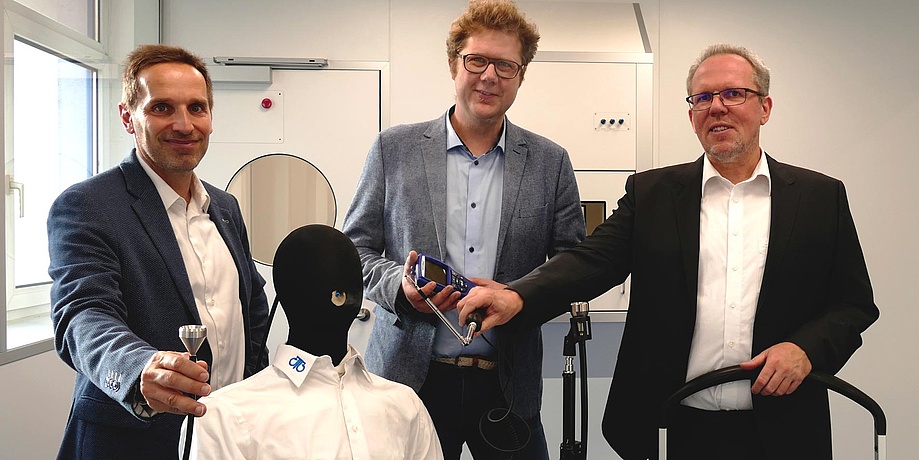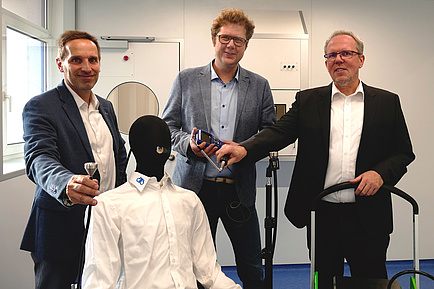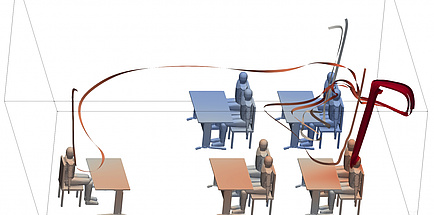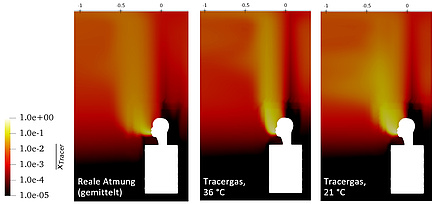Further image material for download can be found at the end of the text
How far apart must people sit from each other to prevent transmission of the coronavirus via the air? Do I need to take any further measures, such as wearing an FFP2 mask? Is the room sufficiently ventilated? Are there any places where the air lingers longer and a ventilation system needs to be retrofitted? Answers to these questions are provided by a new method that was developed within the framework of the FFG research project Prüf-COVID and added to the service portfolio of the indoor hygiene specialist IBO Innenraumanalytik.
Application of tracer gases
The central component of the method is a so-called tracer gas, which can be used to model the distribution of coronavirus particles and other infectious aerosols. This CO2-based gas mixture was developed at the Institute of Process and Particle Technology at Graz University of Technology (TU Graz), as TU Graz researcher Stefan Radl explains: “The tracer gas behaves the same as aerosols with coronaviruses. The challenge was to find a mixture that on the one hand is good and easy to measure and on the other hand describes the movement of infectious aerosols well.” Taking these factors into account, as well as parameters that influence aerosol transmission – such as light, temperature, room humidity or ventilation – Radl and his team used simulations and calculations to determine the mixture that comes closest to the dispersion behaviour of the coronavirus particles, which are only a few micrometres in size, in warm breathing air. The dispersion behaviour in the vertical direction is of particular interest. Breathing air and the aerosol particles it contains typically rise to the ceiling of a room.
Real-life tests with heated dummies
Dummies that simulate human heat emission form the second pillar of the measurement method. Most indoor air tests usually take place in an empty room. But thermally-driven flows play an important role in the dispersion and distribution of aerosols. And this is influenced by human heat emission. “If a person is present in the room, they drive the air flow with their body temperature and thus essentially determine how aerosols are distributed, how long they stay in the air and whether and when they sink to the ground,” explains Radl.
For tests in large communal spaces, several dozen special high-tech dummies can be used. However, this is very cost-intensive and not always possible for budgetary reasons. That is why the project partners, together with Cleanroom Technology Austria created a low-cost alternative by means of specially developed, movable and heated dummies. This embodies the infected person or, in Radl’s words, “the spreader from which we let the tracer gas flow out continuously and at the right temperature.” Depending on the size and nature of the room, any number of these low-cost dummy alternatives can be placed, with a single dummy already providing very meaningful observations. To ensure that the test reflects real breathing as closely as possible, Radl and his team analysed various boundary conditions for temperature and breathing in so-called computational fluid dynamics (CFD) simulations and determined the optimal conditions for different scenarios. Finally, measurements are taken with mobile sensors that are placed at neuralgic points in the room. In order to validate the measurement method, measurements were carried out together with Cleanroom Technology Austria using special test aerosols from cleanroom technology.
Measuring method in use
Companies can now make use of the measurement method via IBO Innenraumanalytik and determine the relative risk of coronavirus transmission indoors. “All rooms with a high occupancy rate and a high number of people are suitable. These can be public transport as well as open-plan offices or opera houses and concert halls as well as other event halls,” says Peter Tappler, managing director of IBO Innenraumanalytik, naming a few examples and immediately providing arguments for the measurements: “If the results are not satisfactory, improvements can be made, for example by distributing the seats or adjusting the ventilation in certain areas. If, on the other hand, the room is virus-proof, that is a weighty signal to the security needs of the respective target groups in this day and age.” After all, everyone prefers to stay in places where they feel safe.




